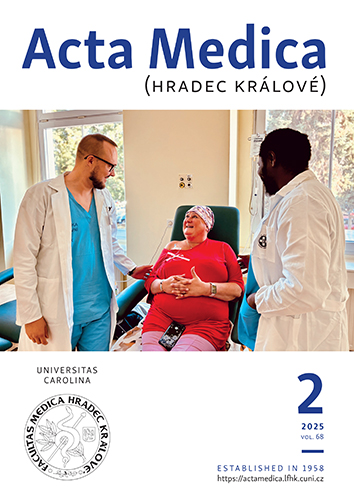ACTA MEDICA, Vol 58 No 4 (2015), 135–143
The Evaluation of the Potency of Newly Developed Oximes (K727, K733) and Trimedoxime to Counteract Acute Neurotoxic Effects of Tabun in Rats
Jiří Kassa, Jana Hatlapatková, Jana Žďárová Karasová
DOI: https://doi.org/10.14712/18059694.2016.6
published online: 10. 03. 2016
abstract
Aim: The ability of two newly developed oximes (K727, K733) to reduce tabun-induced acute neurotoxic signs and symptoms was evaluated and compared with currently available trimedoxime in rats. Methods: The neuroprotective effects of the oximes studied combined with atropine on Wistar rats poisoned with tabun at a lethal dose (380 μg/kg i.m.; 90% of LD50 value) were evaluated. Tabun-induced neurotoxicity was monitored by the functional observational battery consisting of 38 measurements of sensory, motor and autonomic nervous functions at 2 hours following tabun challenge. Results: All tested oximes combined with atropine enable tabun-poisoned rats to survive till the end of experiment. Both newly developed oximes (K727, K733) combined with atropine were able to decrease tabun-induced neurotoxicity in the case of lethal poisoning although they did not eliminate all tabun-induced acute neurotoxic signs and symptoms. Conclusion: The ability of both novel bispyridinium oximes to decrease tabun-induced acute neurotoxicity was slightly lower than that of trimedoxime. Therefore, the newly developed oximes are not suitable for the replacement of commonly used oximes such as trimedoxime in the treatment of acute tabun poisonings.
keywords: Tabun; Neurotoxicity; Functional observational battery; Oximes; Rats

The Evaluation of the Potency of Newly Developed Oximes (K727, K733) and Trimedoxime to Counteract Acute Neurotoxic Effects of Tabun in Rats is licensed under a Creative Commons Attribution 4.0 International License.
210 x 297 mm
periodicity: 4 x per year
print price: 150 czk
ISSN: 1211-4286
E-ISSN: 1805-9694
